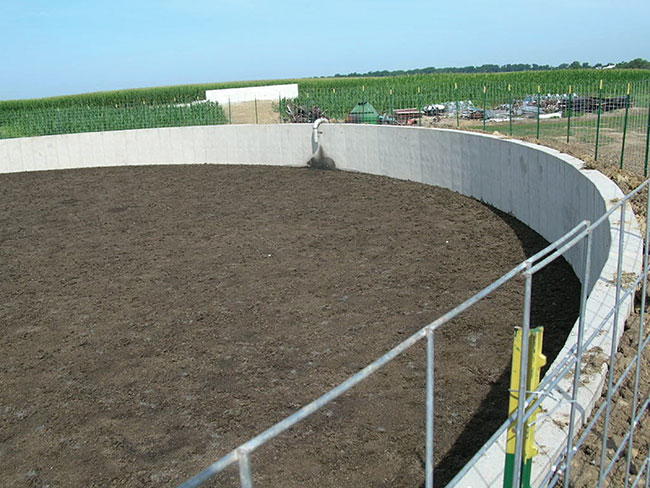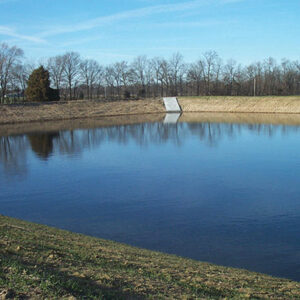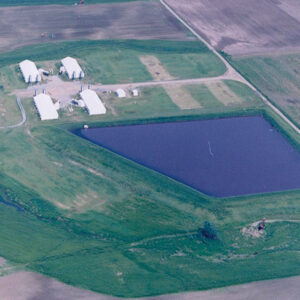
Features
Equipment
Storage
Lagoon safety in a wetter world
Responsible storage and effective prevention strategies are key.
July 24, 2023 by Jack Kazmierski
 All images courtesy of Aaron Orebaugh
All images courtesy of Aaron Orebaugh A common form of liquid storage, manure lagoons are a practical solution to a perennial problem: how to store large amounts of manure before it’s needed as a fertilizer.
A report published by the Mississippi State University Extension Service sums up the benefits of this manure storage system: “Lagoons are pond-like earthen basins sized to provide biological treatment and long-term storage of animal waste. Livestock lagoons are small-scale waste treatment plants containing manure that is usually diluted with water and rainfall. Lagoons are designed to enhance microbial digestion of organic matter and volatilization of nitrogen compounds, thereby reducing the land area requirements for disposal by 50 to five percent.”
While the benefits of lagoons are clear, there are some challenges and dangers that need to be considered and managed when employing this manure storage system.
A Mississippi State University Extension Service report explains the issue: “There is a danger of effluent leaching into groundwater if the lagoon leaks, so proper lagoon construction is required. Overflow events or embankment failure can result in large volumes of effluent discharge with severe environmental impacts (fish kills, water quality destruction, and soil contamination) and legal consequences (fines, penalties).”
The report then offers the following advice: “Lagoons should be filled with water [from] one-third to one-half of the design volume before introducing manure into the lagoon. This will minimize start-up odors and ensure sufficient dilution water is available for the establishment of bacterial activity.
“Starting a new lagoon in late spring/early summer is best and will allow establishment of a bacterial population before cold weather and help prevent excessive odors the following spring.
“Generally, the bottom liner of most lagoons is compacted earth. Some type of clay is the preferred material. Materials such as bentonite can be added to improve the acceptability of soil for liner material. If the soil type is inappropriate, then an impervious liner may need to be added (plastic, concrete, etc.).”
Preventing spills and overflow
Even if a lagoon is properly constructed, problems can arise if the lagoon is filled beyond capacity. A major rainfall, for example, can cause lagoons to overflow, adversely affecting the environment, wildlife and even the human population.
The University of Minnesota Extension published a paper in 2021 outlining some of the measures farmers can take to prevent this problem. The paper explained that most manure spills occur when a lagoon overflows or is damaged. The solution: “Monitor and pump pits and lagoons before they reach the level where a large rain event could cause overflow. Installing a liquid level marker/gauge is a good way to monitor pit/lagoon depth since it will indicate when storage is getting too full. Inspecting pits and lagoons for any rodent or erosion damage will also help prevent spills or leakage. Fix any damage found immediately so that the problem does not worsen.”
Bill Field, professor, department of agricultural and biological engineering at Purdue University explains that measuring the liquid level is vital and that it’s not something that should be left to chance. “Many locales have zoning ordinances in place about how full [lagoons] can be before you have to stop adding manure to them,” he explains.
Diligent monitoring of lagoons is a must. A 2020 report published by North Dakota State University, entitled “Manure Spills: What You Need to Know and Environmental Consequences,” stressed that “Prevention is always the best means to minimize the risk of manure spills and the resulting environmental damage.”
The report recommended taking the following steps to prevent manure spills from lagoons: “(1) Install a permanent marker/staff gauge and regularly monitor manure levels. (2) Make proper liquid level management a year-round priority. (3) Reserve maximum storage capacity for times when open fields are not available/extended wet weather prevents application. (4) Pump down the liquid level or take action to remove liquid from storage and properly apply or transfer it to another storage structure when the pond has reached its maximum operating level.”
Lagoon covers
While water is essential for a lagoon to function properly, too much of it can be a problem. A cover would seem like a natural way to keep excess water out of a lagoon, but as Purdue University’s Field explains, that’s not always possible, practical or cost-effective.
“There are lagoons that are smaller, deeper and have covers over them,” explains Field, “And they’re often found where you have a lot of rainfall. But some lagoons cover several acres, and building a roof over them would costs hundreds of thousands of dollars.”
While a solid roof isn’t always cost-effective or possible, some lagoons benefit from other types of covers. Iowa State University, Extension and Outreach published a report on how a variety of permeable and impermeable covers can reduce odors and emissions from lagoons. The report highlighted the pros and cons of both types of covers.
According to the report, an impermeable cover “increases nitrogen retention in the manure, reduces dilution of manure due to rainwater, and can be used to capture methane gas produced by manure.” A permeable cover, on the other hand, will not reduce dilution of manure from rainwater or capture gases, but will increase nitrogen retention. It’s also easier to apply.
The same report offered examples of permeable covers: “natural crusts, layers of natural vegetative materials (such as straw, corn stalks, ground corncobs, etc.), vegetable oils, permeable fabrics (geotextiles), as well expanded clays, ceramics, and ground rubbers (examples include LECA and Macrolite).”
Impermeable covers, according to the report can be either rigid and flexible. “Examples of rigid covers include concrete, wood/metal roofed structures, and plastic coated fabrics stretched over framing,” the report explained. “Flexible covers are generally plastics, including geomembranes and geosynthetic materials, are typically constructed of high-density polyethylene, linear low-density polyethylene, polyvinyl chloride, or similar.”
The report added that “impermeable covers provide excellent odor and emission control, but have a high capital cost. Permeable covers generally are not as effective, but generally have a substantially lower capital cost.”
Freak storms
Occasionally, freak storms can overwhelm a lagoon, whether or not it has a roof or a cover. Massive amounts of rainfall can cause lagoons to flood, leading to an environmental disaster. The only way to deal with these once-in-a-century weather events is to prevent the disaster from happening in the first place. In other words, the lagoon must never be allowed to overflow in the first place.
As noted in the report from North Dakota State University, “Prevention is always the best means to minimize the risk of manure spills and the resulting environmental damage.” That’s why when back-to-back storms dumped excessive amounts of rain on Western Washington in late 2021, everyone worked together to prevent a disaster.
Whatcom and Skagit counties were hit especially hard by the storms, and according to reports, a total of more than 30 million gallons of liquid manure was at risk of spilling out of lagoons and into the environment in those two counties.
No amount of cover, and no roof would be enough to handle the deluge. The only solution was to move the manure out of the lagoons before they overflowed, which is why the state Department of Ecology, the Conservation Commission, local officials and the affected farmers worked together to avert the disaster.
Some of the manure was pumped through existing buried manure lines, and some was trucked out of harm’s way. Some farmers used their own trucks, while others hired contractors. According to a report published by the Washington State Department of Health, the cost of moving all that manure was roughly $360,000, but well worth it when contrasted with the cost of the environmental disaster that was averted.
That same Washington State Department of Health report concluded with a statement that puts into perspective the challenges facing communities throughout North America as our planet deals with climate change: “Recent rains continue to threaten water quality in Western Washington. We continue to work to keep people in Washington safe from disease when flooding and other incidents occur.”
Indeed, as weather patterns change, leaving some part of North America wetter than others, it will be increasingly important for everyone to work together, and for lagoons to be properly maintained and properly managed.
The key to averting a disaster, whether it’s caused by a single lagoon leaking its contents into nearby water systems, or by a once-in-a-century rainfall event, we’re going to have to work together with the same mantra in mind: “Prevention is always the best means.” •

